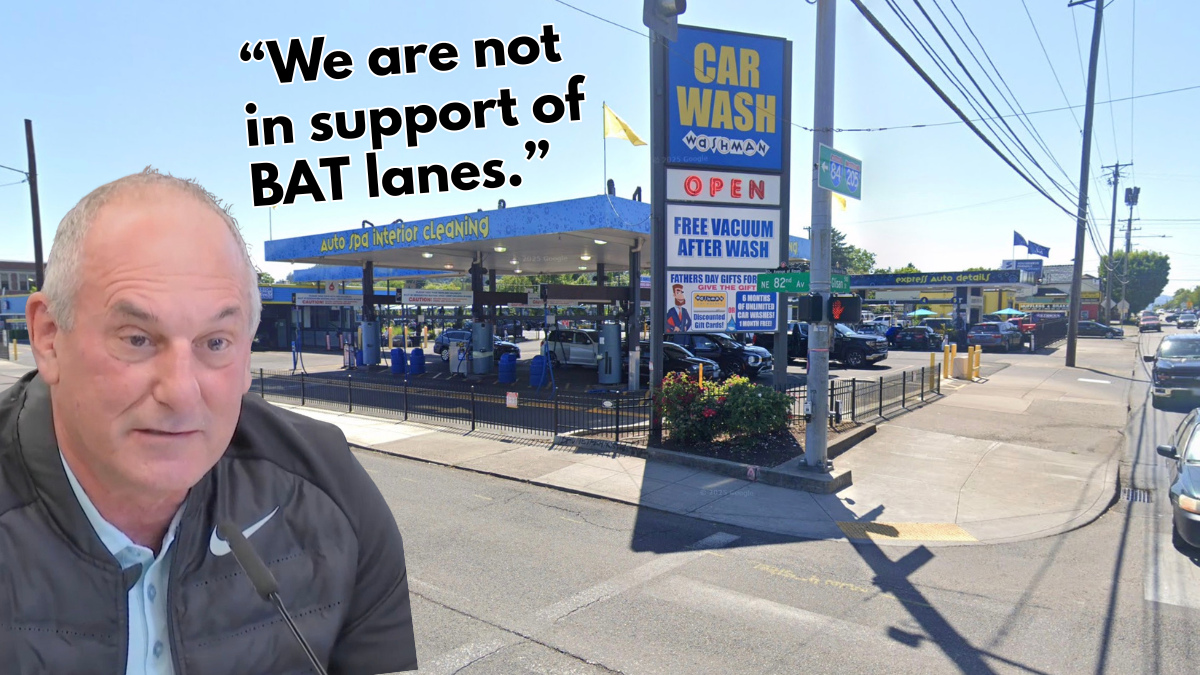On Friday at the Policy and Budget Committee meeting for 82nd Avenue Transit Project, the CEO of a business that has two outlets in the project area testified in opposition to building better bus lanes. But as I listened to this influential person make their case, it just didn’t ring true. I figured since TriMet is very concerned about business owner opposition, it’s worth taking a closer look at one of their arguments.
Washman Car Wash CEO David Tarlow made it clear in his testimony that Washman does not support Business Access and Transit – or “BAT” – lanes on 82nd Avenue. But the proposal he described in his testimony isn’t even what’s actually being proposed. Below are some false claims and other misunderstandings and/or misrepresentations Tarlow made in his testimony, followed by my thoughts.
“The proposal is that two entire lanes of 82nd — both northbound and southbound — will be closed to motor vehicles and the bus lanes will take their place.”
That is incorrect. The proposal would convert the curbside lane in each direction from a general travel lane to a BAT lane. BAT lanes explicitly allow car users inside of them. TriMet puts “business access” in the name to clarify that.
“… Creating serious additional congestion, taking away 50% of 82nd Avenue’s capacity just to speed up transit times by just a few minutes, but causing the same, or worse, corresponding delays for motor vehicle traffic.”
This is also a misrepresentation of the facts. TriMet’s numbers show that the “More BAT” option (that would build continuous bus lanes on seven miles of 82nd Ave from Clatsop to Lombard) would speed up buses by 11 to 14 minutes. In project documents, TriMet says even without an BAT lanes, buses would be 8-10 minutes faster than current conditions due to new signals, better buses, and so on. The “More BAT” option would add an additional 3-4 minute time saves for bus users. Taken together, that’s a transit trip that would be 8-14 minutes faster — compared to an estimated 3-4 minute delay for car users.
As for capacity, given how much more efficient buses are compared to cars, giving more space to more buses would actually increase the capacity of 82nd Avenue.
“82nd Avenue is a highway corridor that drivers use to get from Southeast Portland to Northeast Portland, and it should not be turned into a local street.”
Since Tarlow clearly only started following this project once he felt threatened by new bus lanes, he must not realize that 82nd Avenue is no longer a highway and that it was already turned into a local street three years ago. If that issue was a concern of his, he should have advocated before the owners of 82nd was officially transferred from the State of Oregon to the City of Portland.
“This proposal would add serious impediments to vehicles trying to get to 82nd Avenue business destinations.”
The proposal would actually remove all through car traffic from two lanes — which to me sounds like removing a serious number of “impediments” (other cars) to drivers trying to get to businesses.
“[The bus lanes]… would lead to frustrated drivers, empty bus only lanes, and more traffic diversion into local streets, resulting in those neighborhood streets becoming less safe for those residents that walk, ride their bikes and kids playing.”
Tarlow is right that the bus lanes would often be empty, giving car drivers even better access to businesses than they have today. And if diversion into neighborhoods became a problem, the answer would be the installation of modal filters and other traffic calming tools to keep drivers from cutting through. Also keep in mind, when drivers cut through neighborhoods it doesn’t have to make streets unsafe. The streets become unsafe when those drivers choose to drive dangerously.
“The congestion caused by taking away 50% of the lane capacity will not only result in increased congestion, as previously mentioned, but will also result in 82nd Avenue becoming a more dangerous corridor to drive on.”
The fewer cars we have on 82nd Avenue, the safer it will be. The more buses we have on 82nd Avenue the safer it will be. Of the 20 people killed while using 82nd Avenue in the past decade, not one of them was hit by a bus operator, while car drivers were involved in all of them.
“I-205, is already at capacity, so those vehicles that normally travel on 82nd will no longer use that route. They will utilize neighborhood streets, take their shopping, etc, to other locations in the city to avoid the congestion, and as mentioned previously, cause businesses to eventually close their doors and move to more viable locations.”
I shouldn’t have to point out the folly of that argument, but it also makes the point that cars are extremely inefficient and a business corridor designed around them lacks the resiliency and capacity necessary to compete for business in 2025.
I realize why someone who’s a CEO of a car wash feels threatened by this project, but if Tarlow is going to take the extraordinary step of becoming an outspoken critic of it, the least he can do is come up with a factual, good-faith argument against it.
For a different view of this story, watch it on YouTube.




